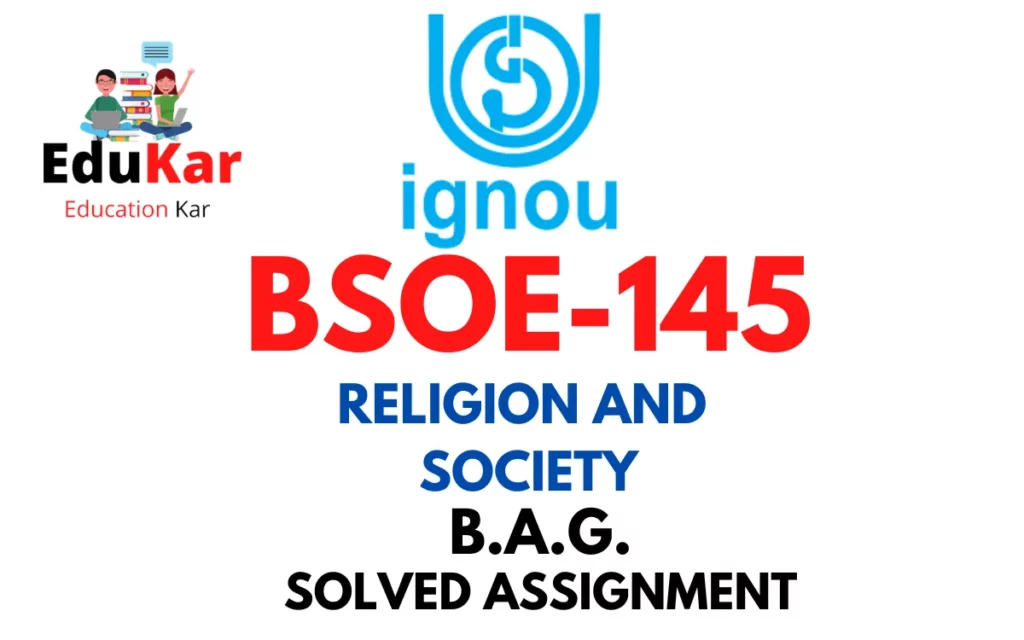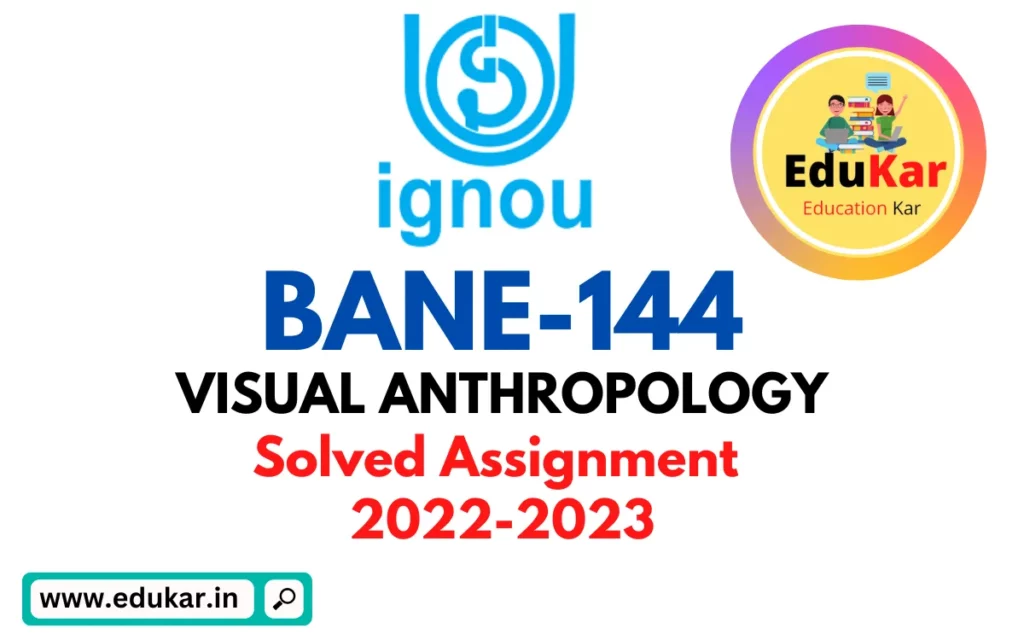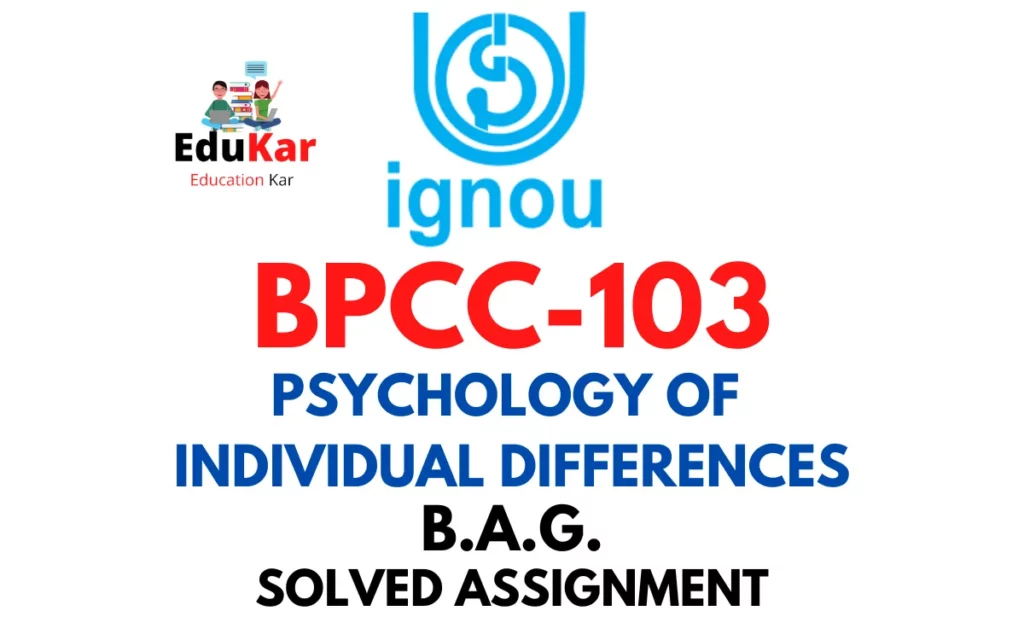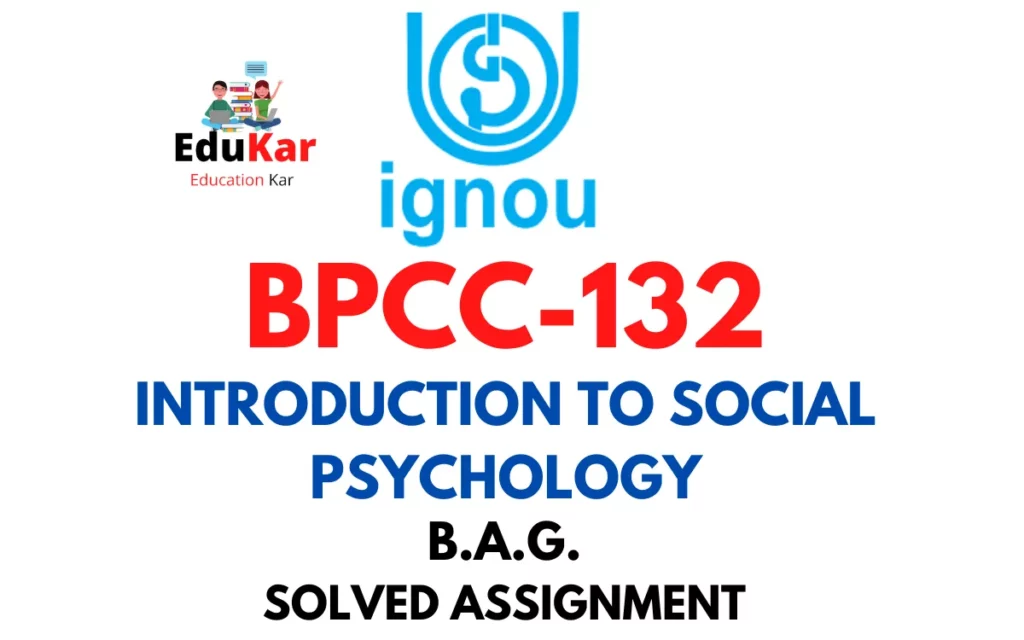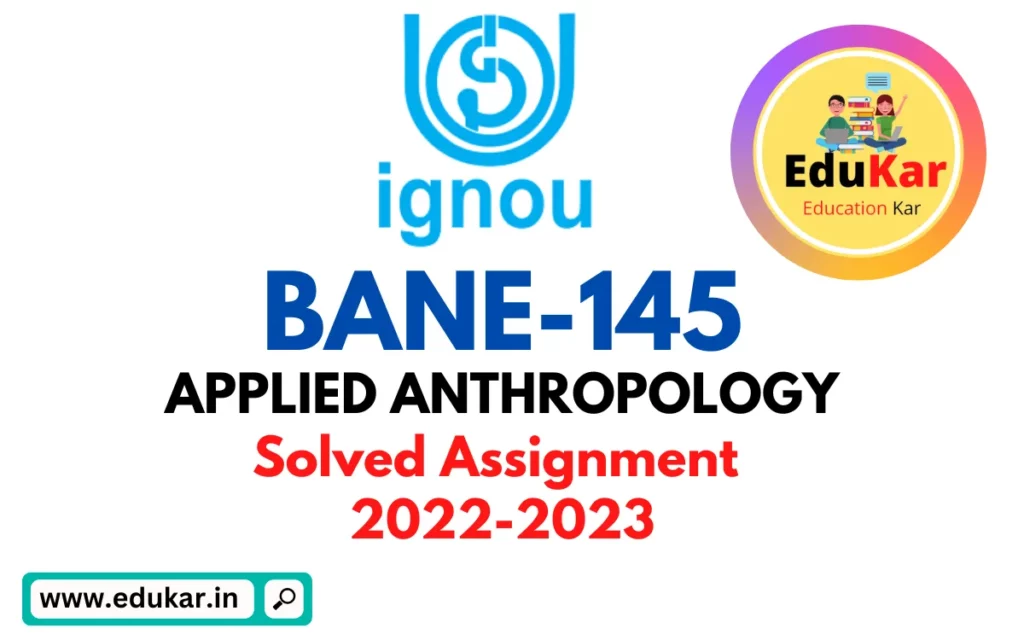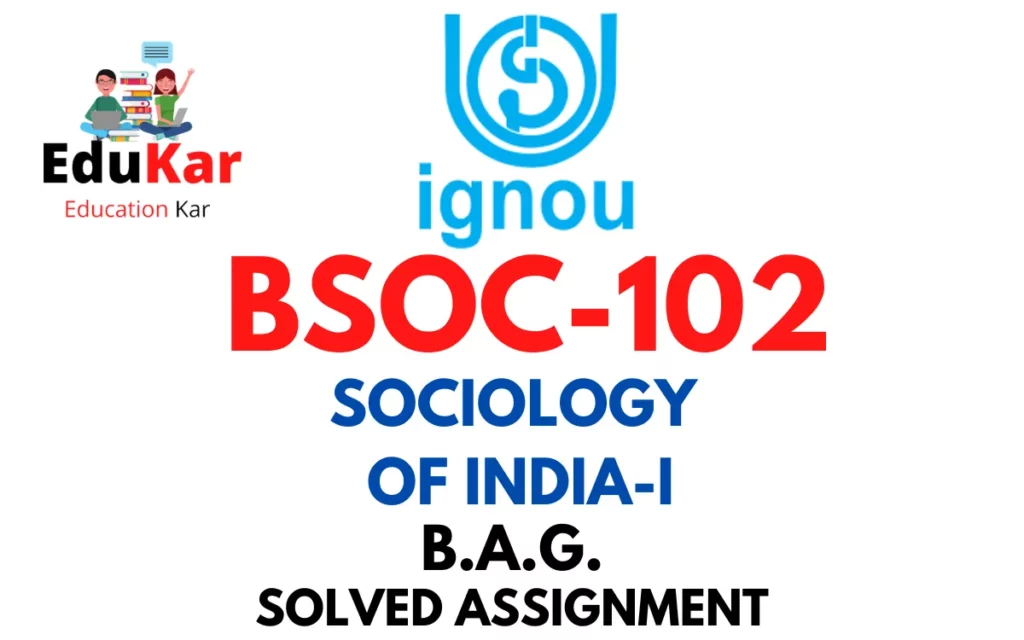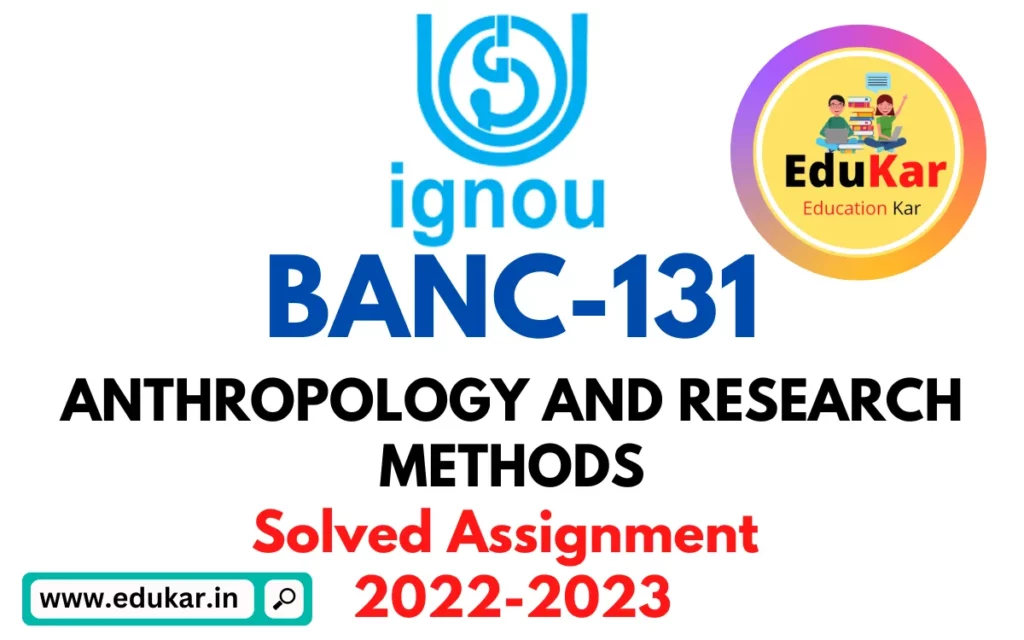Contents
- 1 Assignment A
- 2 Answer the following in about 500 words each.
- 3 1. How was Indian civilization seen through the cultural essence approach.
- 4 2. Critically examine the Indological view of India.
- 5 Assignment B
- 6 Answer the following questions in about 250 words each.
- 7 3. Explain the nature of political unification brought about by the British in India.
- 8 4. Discuss the Indian village as an economic unit.
- 9 5. How does the Constitution of India safeguard the linguistic diversity of India?
- 10 Assignment C
- 11 Write a note on the following in about 100 words each.
- 12 6. Minority groups
- 13 7. Parallel and Cross-cousins
- 14 8. Pastoralists
- 15 9. Pandita Ramabai
- 16 10. Zamindari System

| Title | IGNOU-BSOG 171 Solved Assignment 2022-2023 (Indian Society: Images and Realities) |
| University | IGNOU |
| Degree | Bachelor Degree Programme |
| Course Code | BSOG 171 |
| Course Name | Indian Society: Images and Realities |
| Programme Name | Bachelor of Arts (General) |
| Programme Code | BAG |
| Total Marks | 100 |
| Year | 2022-2023 |
| Language | English |
| Assignment Code | ASST /TMA / July 2022-23 |
| Last Date for Submission of Assignment: | For June Examination: 31st March For December Examination: 30th September |
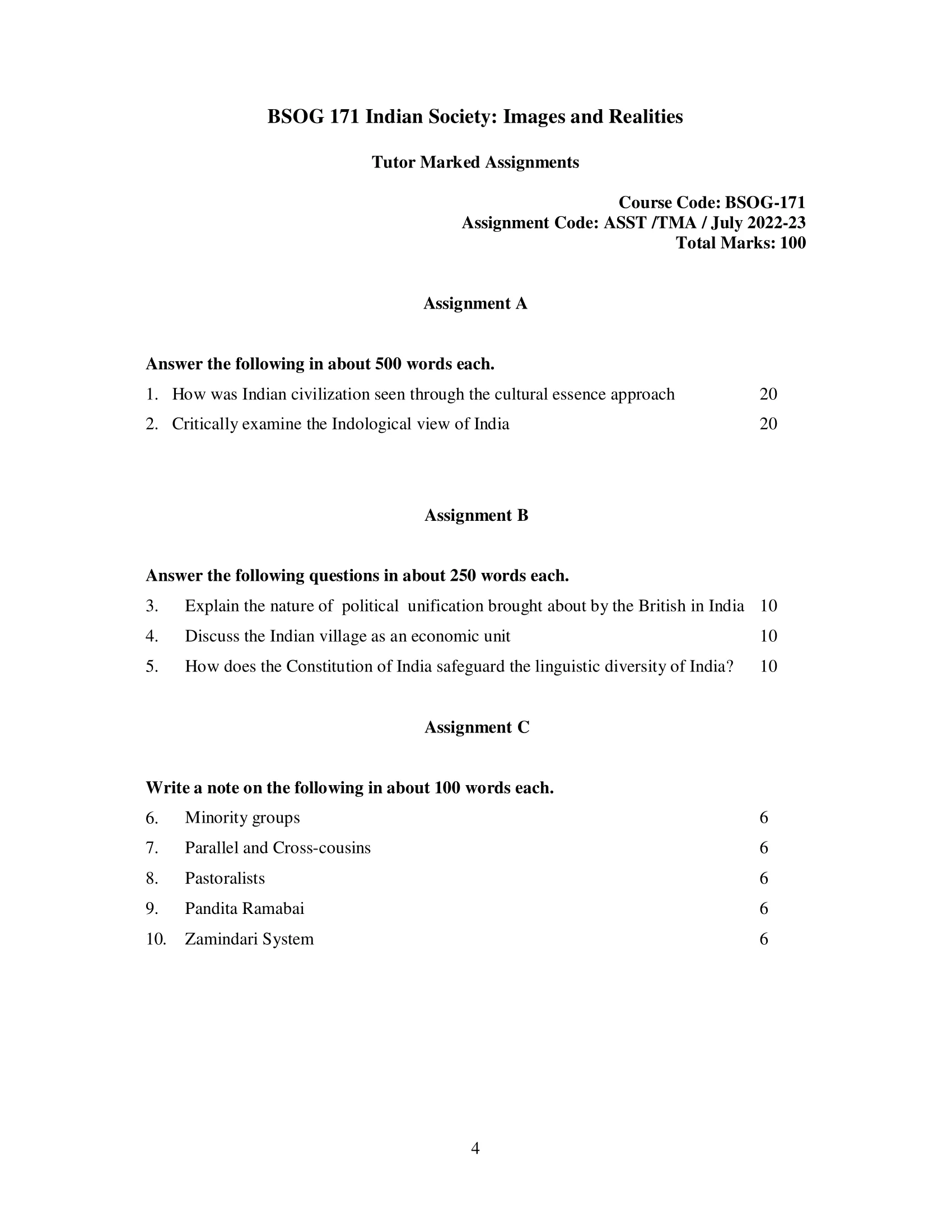
Assignment A
Answer the following in about 500 words each.
1. How was Indian civilization seen through the cultural essence approach.
Ans: Indian civilization, one of the oldest in the world, has been studied and analyzed through various lenses. The cultural essence approach is one such lens that looks at the civilization through the cultural and spiritual values that have defined the nation and its people.
From ancient times, India has been a land of diverse cultures and religions, and this diversity has been one of the defining characteristics of its civilization. The religious beliefs and practices of Hinduism, Buddhism, Jainism, and Sikhism have greatly influenced the cultural essence of the Indian society. The ancient scriptures and texts like the Vedas, the Upanishads, the Bhagavad Gita, and the Puranas have served as the guiding lights for the people and have imparted moral and ethical values that are still relevant today.
The concept of ahimsa (non-violence), for instance, has been an integral part of Indian culture and has been central to the teachings of many religious and spiritual leaders. This value has found expression in the Indian way of life, in the form of vegetarianism, and in the Gandhian movement for independence. The idea of dharma, which encompasses the moral and ethical responsibilities of an individual, is another such value that has been central to Indian civilization.
The rich cultural heritage of India is also evident in its art and architecture. From the rock-cut caves of Ajanta and Ellora to the towering temples of Khajuraho, Indian architecture has been an expression of the cultural and spiritual values of the people. The sculptures and paintings in these temples are a testament to the rich artistic traditions of India, which have been handed down through generations.
Indian classical music and dance are other forms of cultural expression that have been an integral part of the Indian civilization. From the devotional bhajans to the sophisticated classical forms like Kathak and Bharatanatyam, Indian music and dance have been an expression of the emotions and spiritual experiences of the people.
2. Critically examine the Indological view of India.
Ans: The Indological view of India is a perspective that has been shaped over centuries by Western scholarship and seeks to understand the Indian civilization and culture through the lens of Western thought and values. This view has been influential in shaping the popular understanding of India and its people, but it has also been criticized for being limited, incomplete, and often biased.
One of the key criticisms of the Indological view is that it has been based on a limited set of sources and has failed to take into account the diversity of experiences and perspectives within Indian society. This has resulted in a one-dimensional view of India that neglects the complexity and richness of its civilization and culture. For instance, Indologists have often portrayed ancient Indian society as being static and unchanging, ignoring the dynamic processes of change and evolution that have shaped the Indian civilization.
Another criticism of the Indological view is that it has often been based on colonial-era scholarship that was driven by colonial interests and a desire to understand and control India. This has resulted in a view of India that is heavily influenced by colonial perspectives and biases, and fails to accurately represent the Indian civilization and culture.
The Indological view has also been criticized for being Eurocentric, as it has been shaped by Western philosophical and cultural traditions and has often been used to compare and evaluate Indian civilization and culture in terms of Western values and norms. This has resulted in a narrow and limited understanding of India that fails to appreciate the unique contributions and perspectives of Indian civilization.
In addition, the Indological view has been criticized for its focus on the ancient past, to the exclusion of the more recent and contemporary aspects of Indian society. This has resulted in a view of India that is disconnected from the realities of the modern world, and fails to take into account the significant changes and developments that have taken place in India in recent times.
Despite these criticisms, the Indological view of India has had a profound impact on the way that India and its people have been perceived and understood in the Western world. It has also played a significant role in shaping the study of Indian civilization and culture and has provided valuable insights into the rich and diverse heritage of India.
Assignment B
Answer the following questions in about 250 words each.
3. Explain the nature of political unification brought about by the British in India.
Ans: The British political unification of India was a process that took place over a period of several centuries, beginning in the late 18th century and lasting until the mid-20th century. This process was driven by a combination of economic, military, and administrative factors. The British East India Company was the primary agent of British control over India, using its military power to conquer and control large parts of the subcontinent.
The British implemented a number of policies aimed at unifying India politically and administratively, including the creation of a centralized system of government, the establishment of a uniform legal code, and the construction of a nationwide infrastructure of roads, railways, and telegraph lines. These efforts helped to consolidate British control over India and created the conditions for a more integrated political and administrative system.
Despite the political and administrative unification brought about by the British, India remained a highly diverse and fragmented society, with different regions, religions, and ethnic groups maintaining their own distinct cultural and political traditions. The British also maintained a policy of divide-and-rule, pitting different groups against each other in order to maintain their control over the country.
The political unification of India brought about by the British had a profound impact on the subcontinent, shaping its modern political and economic landscape. On one hand, it helped to create a more integrated and connected country, laying the foundations for a modern nation-state. On the other hand, it also contributed to the marginalization and oppression of many groups, fueling resistance and struggles for independence. Today, India continues to be a country of great diversity, but it remains unified politically and administratively, with a strong central government and a vibrant democratic system.
4. Discuss the Indian village as an economic unit.
Ans: The Indian village has traditionally been seen as an economic unit, with agriculture being the main source of livelihood for the majority of the population. Agriculture has been the backbone of the Indian economy for centuries, providing sustenance and employment to millions of people across the country. Villages in India have a rich cultural heritage and a strong sense of community, with people living and working together in close-knit groups.
Agricultural production in Indian villages is often characterized by small and fragmented landholdings, low levels of investment, and limited use of modern technology. This has resulted in low productivity levels and limited economic growth in many rural areas. The government has implemented various programs aimed at improving the economic conditions in villages, including investment in infrastructure, support for small and medium-sized enterprises, and the promotion of agribusiness.
Despite the challenges, the Indian village continues to be an important source of economic activity, with many villages boasting a thriving local economy. The informal sector, including small-scale businesses, handicrafts, and services, plays a significant role in generating employment and income for rural residents. The development of non-farm activities, such as tourism, has also become an important source of income for many villages.
5. How does the Constitution of India safeguard the linguistic diversity of India?
Ans: The Constitution of India recognizes the importance of linguistic diversity and provides several provisions to safeguard the rights of linguistic minorities. The Constitution recognizes the official use of 22 different languages, including Hindi and English, and acknowledges the importance of preserving the diversity of Indian languages.
One of the key provisions of the Constitution that safeguards linguistic diversity is the use of the federal system of government. This system allows for the decentralization of power and decision-making, ensuring that local languages and cultures are protected and recognized. Additionally, the Constitution provides for the establishment of special linguistic schools and colleges, as well as the use of mother tongue in the education system.
Another important provision of the Constitution is the guarantee of the freedom of speech and expression, which includes the right to use any language. This provision is important in ensuring that linguistic minorities are able to express themselves freely and to preserve their cultural heritage.
The Constitution also provides for the establishment of linguistic provinces, which allows for the creation of states based on linguistic identities. This has helped to preserve the linguistic and cultural heritage of different regions and has ensured that the rights of linguistic minorities are protected.
Assignment C
Write a note on the following in about 100 words each.
6. Minority groups
Ans: Minority groups are defined as social groups that have less power, fewer resources, and a smaller representation in a society compared to the dominant group. They may be differentiated based on characteristics such as race, ethnicity, religion, language, sexuality, and ability. Minority groups often face discrimination, prejudice, and unequal treatment due to their minority status. They are also frequently subject to institutionalized forms of oppression and marginalized in political, economic, and social spheres. It is important to acknowledge and address the challenges faced by minority groups in order to create a more inclusive and equitable society. This involves promoting diversity, challenging systemic inequalities, and advocating for the rights of minority groups.
7. Parallel and Cross-cousins
Ans: Parallel cousins and cross-cousins are terms used to describe the relationship between cousins in a family. Parallel cousins are the children of siblings of the same gender, while cross-cousins are the children of siblings of the opposite gender. For example, a person’s mother’s brother’s child and a person’s father’s sister’s child are considered cross-cousins.
In many cultures, the relationship between parallel and cross-cousins can have significant cultural and social implications. For instance, cross-cousins may have a closer relationship and be expected to have a stronger bond, while parallel cousins may have a more distant relationship. The relationship between cousins also affects the dynamics of inheritance and property rights. Understanding the cultural and social significance of parallel and cross-cousin relationships is important for understanding family dynamics and relationships in different cultures.
8. Pastoralists
Ans: Pastoralists are people who rely on raising livestock, such as cattle, sheep, and goats, for their livelihood. They live a nomadic or semi-nomadic lifestyle, moving their herds to different grazing lands in search of fresh pasture for their animals. Pastoralism is a traditional way of life for many communities in Africa, Asia, and the Middle East.
Pastoralists play an important role in maintaining biodiversity and ecological balance in their ecosystems. They also contribute significantly to the economies of their regions through the sale of livestock and dairy products. However, pastoralists often face challenges such as loss of grazing land, conflict with farmers and other groups, and the impact of climate change.
Recognizing the importance of pastoralism and supporting pastoral communities is crucial for sustainable development and food security. This involves promoting policies that respect the rights and livelihoods of pastoralists, protecting their grazing lands, and ensuring their access to markets and other resources.
9. Pandita Ramabai
Ans: Pandita Ramabai was a 19th-century Indian social reformer and activist who dedicated her life to improving the status of women in India. She was born into a Brahmin family in Maharashtra and became a child widow at the age of 11. Despite facing discrimination and opposition, she became one of the first women in India to receive a modern education.
Ramabai was a strong advocate for the education and empowerment of women and worked to improve the lives of widows and girls. She established the Sharada Sadan, a home for widows, and the Mukti Mission, a school for girls. She also wrote several books, including “The High-Caste Hindu Woman,” which provided a critical perspective on the treatment of women in Hindu society.
Ramabai’s work and activism were influential in shaping the Indian women’s movement and her legacy continues to inspire generations of women activists and reformers. She remains a symbol of courage, determination, and the fight for women’s rights in India.
10. Zamindari System
Ans: Zamindari System was a feudal land tenure system in India that existed during British rule. It allowed landlords, called zamindars, to collect rent from tenant farmers in exchange for the right to use the land. This system was widely criticized for its exploitation of the rural population and their poverty, as well as the lack of security and protection for tenants. The government eventually abolished the Zamindari System in the 1950s, through the Zamindari Abolition Act, aimed at promoting land reform and ending the economic exploitation of rural communities. The act redistributed land to tenant farmers and provided them with ownership rights. The Zamindari System remains a significant part of India’s history, as it illustrates the impact of colonialism and the struggle for land rights in the country.
How to Download BSOG 171 Solved Assignment?
You can download it from the www.edukar.in, they have a big database for all the IGNOU solved assignments.
Is the BSOG 171 Solved Assignment Free?
Yes this is absolutely free to download the solved assignment from www.edukar.in
What is the last submission date for BSOG 171 Assignment?
For June Examination: 31st March, For December Examination: 30th September



